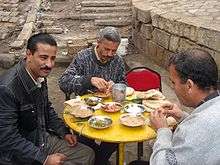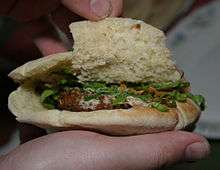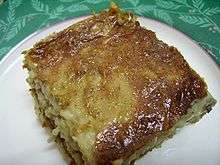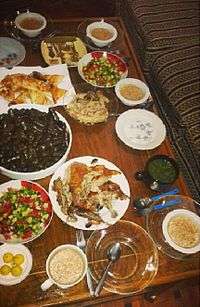Egyptian cuisine
| Life in Egypt |
|---|
 |
| Culture |
| Demography |
| Politics |
| Wildlife |
Egyptian cuisine makes heavy use of legumes, vegetables and fruits since Egypt's rich Nile valley and delta produce large quantities of these crops in high quality.
Bread
Bread made from a simple recipe forms the backbone of Egyptian cuisine. It is consumed at almost all Egyptian meals; a working-class or rural Egyptian meal might consist of little more than bread and beans.
The local bread is a form of hearty, thick, glutenous pita bread called Eish Masri or Eish Baladi or Baladee (Egyptian Arabic: عيش [ʕeːʃ]; Modern Standard Arabic: ʿayš) rather than the Arabic خبز ḫubz. The word "[ʕeːʃ]" comes from the Semitic root ع-ي-ش ʕ-Ī-Š with the meaning "to live, be alive."[1] The word ʿayš itself has the meaning of "life, way of living...; livelihood, subsistence" in Modern Standard and Classical Arabic; folklore holds that this synonymity indicates the centrality of bread to Egyptian life.[1] In modern Egypt, the government subsidizes bread, dating back to a Nasser-era policy. In 2008, a major food crisis caused ever-longer bread lines at government-subsidized bakeries where there would normally be none; occasional fights broke out over bread, leading to fear of rioting.[2] Egyptian dissidents and outside observers of the former National Democratic Party regime frequently criticized the bread subsidy as an attempt to buy off the Egyptian urban working classes in order to encourage acceptance of the authoritarian system; nevertheless, the subsidy continued after the 2011 revolution.

On a culinary level, bread is commonly used as gamosa, a utensil, at the same time providing carbohydrates and protein to the Egyptian diet. Egyptians use bread to scoop up food, sauces, and dips and to wrap kebabs, falafel, and the like in the manner of sandwiches. Most pita breads are baked at high temperatures (450 °F or 232 °C), causing the flattened rounds of dough to puff up dramatically. When removed from the oven, the layers of baked dough remain separated inside the deflated pita, which allows the bread to be opened into pockets, creating a space for use in various dishes.
Aish Merahrah [ʕeːʃ meˈɾɑħrɑħ] is an Egyptian flat bread made with 5-10% ground fenugreek seeds added to maize flour. It is part of the traditional diet of the Egyptian countryside, prepared locally in village homes. The loaves are flat and wide, and usually about 50 cm in diameter. The maize flour is made into a soft dough that is fermented overnight with the help of a sourdough starter, then shaped into round loaves and allowed to rise or "proof" for 30 minutes before being flattened into round disks, which are then baked. This bread can be kept for days in an airtight container. The addition of fenugreek seeds increases the protein content, storage length and digestibility of the bread; on the other hand, it causes the eater to exude a distinctive odor in his or her sweat, which is occasionally mocked by more urban Egyptians.
Main courses
Egyptian cuisine is characterized by dishes such as ful medames, mashed fava beans; kushari, a mixture of lentils, rice, pasta, and other ingredients; molokhiya, chopped and cooked bush okra with garlic and coriander sauce; and feteer meshaltet. Egyptian cuisine shares similarities with food of the Eastern Mediterranean region, such as rice-stuffed vegetables, grape leaves, shawarma, kebab, ta‘miya, baba ghannoug, and baklava.
Some consider kushari - a mixture of rice, lentils, and macaroni - to be the national dish. Ful medames is also one of the most popular dishes. Fava bean is also used in making falafel (most commonly referred to as ta‘miya in Egypt), which originated in Egypt and spread around to other parts of the Middle East.
Cow brain and liver is eaten in Egypt.[3][4][5][6][6][7][8][9][10][11][12][13] Egyptians also eat sheep brains.[14]


Ancient Egyptians are known to have used a lot of garlic and onions in their everyday dishes. Fresh garlic mashed with other herbs is used in spicy tomato salad and also stuffed in boiled or baked aubergines (eggplant). Garlic fried with coriander is added to molokhiya, a popular green soup made from finely chopped jute leaves, sometimes with chicken or rabbit. Fried onions can be also added to kushari.
| Dish | Definition |
|---|---|
| Baba ghannoug | A condiment made with eggplants, lemon juice, salt, pepper, parsley, cumin and oil. |
| Dakka (IPA: [ˈdæʔʔæ]) | A dry mixture of chopped nuts, seeds, Middle Eastern spices, and flavors. |
| Kebab (IPA: [kæˈbæːb]) | Usually chopped and minced lamb meat on skewers grilled over charcoal. |
| Kofta | Balls of ground or minced meat or sometimes vegetables, often served with spiced gravy. |
| Kebda | Fried liver, with seasonings. The Alexandrine specialty is known as Kebda Eskandarani (Alexandrian liver) which is rather spicier than the usual one. |
| Keshk | A milk or yogurt savory pudding, made with flour, sometimes seasoned with fried onions, chicken broth or boiled chicken. |
| Maḥshi (IPA: [ˈmæħʃi]) | A stuffing of rice, seasoned with herbs and spices, put into vegetables like green peppers, aubergines, courgettes, tomatoes, or cabbage leaves. The stuffed vegetable is then placed in a pot and topped with tomato sauce and lemon or lime. |
| Maḥshi ḥamām (IPA: [ˈmæħʃi ħæˈmæːm]) | Pigeon stuffed with rice or wheat and herbs, then roasted or grilled. |
| Maḥshi wara' ‘enab (IPA: [ˈmæħʃi ˈwæɾæʔ ˈʕenæb]) | Grape leaves stuffed with a rice mixture that can be made either with sauteed ground beef or vegetarian style. The rice is seasoned with crushed red tomatoes, onion, parsley, dill, salt, pepper and Egyptian spices. This mixture is then stuffed and rolled into an individual grape leaf, placed in a pot and topped with tomato sauce and lemon or lime. |
| Mesaʾa‘ah (IPA: [mesæʔˈʔæʕæ]) | Sliced eggplants that are lightly grilled and placed in a flat pan with sliced onions, green peppers, and chili peppers. The dish is then covered with a red sauce made of tomato paste and Egyptian spices and then baked in the oven for 30–40 minutes at 350 degrees F. |
| Molokhiya (IPA: [moloˈxejjæ]) | Green soup prepared in various styles, wherein the mallow leaves are very finely chopped, with ingredients such as garlic and coriander added for a characteristic aromatic taste, then cooked with chicken broth. Other kinds of broths can be used such as rabbit, shrimp, which is popular in Alexandria, and fish in Port Said. It is often considered the country's national dish. |
| Rozz me‘ammar (IPA: [ɾozze m(e)ˈʕɑmmɑɾ]) | A rice dish made by adding milk (and frequently butter or cream) and chicken stock or broth to cooked rice and subsequently baking it in an oven. It is frequently substituted for plain white rice at festive occasions and large family meals. |
| Shawerma (IPA: [ʃæˈweɾmæ]) | A popular sandwich of shredded beef, lamb or chicken meat, usually rolled in pita bread with Tahina sauce. This is a relatively recent import from Levantine cuisine, possibly brought by Lebanese or Palestinian immigrants, it has since become a firm part of the Egyptian culinary landscape. |
| Ṭehina (IPA: [tˤeˈħiːnɑ]) | Sesame paste dip or spread made of sesame tahini, lemon juice, and garlic. Typically served with pita bread. |
| Tehina salad | A condiment made with sesame butter, vinegar, lemon juice, salt, pepper, parsley, cumin and olive oil. |
| Bram rice | Rice made with milk in a special kind of casserole called a bram, baked, and usually served with chicken liver |
| Macaroni béchamel | An Egyptian variant of the Greek pastitsio, typically incorporating gebna rūmī, an Egyptian cheese similar to Sardo or Pecorino cheese, along with a mixture of penne macaroni and béchamel sauce, and usually two layers of cooked spiced meat with onions |
| Shakshouka (IPA: [ʃækˈʃuːkæ]) | Eggs with tomato sauce and vegetables. An Egyptianized import from Moroccan cuisine. |
| Samak mashwi (IPA: [ˈsæmæk ˈmæʃwi]) | Grilled fish. Like most fish dishes, a specialty of Alexandria. |
| Samak ma'li (IPA: [ˈsæmæk ˈmæʔli]) | Fried fish. Another specialty of Alexandria. |
| Torly | A tray of baked squash, potatoes, carrots, onions, and tomato sauce. |
Other dishes include:
- Bamia – a stew prepared using lamb, okra and tomatoes as primary ingredients
- Beeftek (Egyptian Arabic: [bofˈteːk]; veal schnitzel; a French cuisine import)
- Bissara soup
- Kersha (Egyptian Arabic: [ˈkeɾʃæ]; Sheep gelatin with vegetables).
- Besara (بسارة, [beˈsɑːɾɑ]).
- Eggs with basterma.
- Ferakh panée (فراخ پانيه, [feˈɾæːx bæˈneː, -pæ, -pɑ]; “chicken schnitzel”)
- Feseekh (فسيخ, [feˈsiːx]; salted or fermented mullet, generally eaten on the spring festival of Sham El Nessim, which falls on Eastern Easter Monday).
- Feteer: Pies made of thin dough with liberal quantities of samnah. The fillings may be either savory (e.g., cheese, suguq) or sweet (e.g., qishta, jam). Certain types of restaurants specialize in fitir, although since at least the early 2000s they also generally make pizza.
- Kushari (IPA: [ˈkoʃæɾi])
- Shish taouk (IPA: [ʃiːʃ tˤɑˈwuːʔ]); a relatively recent import from the Levant.
- Sayyadeyah (IPA: [sˤɑjjɑˈdejjɑ]).
- Qolqas: Taro root, generally peeled and prepared either with Swiss chard or tomato. Unpeeled qolqas and eggplant make the ṭabkha sawda, or "black dish," served to and despised by conscripts in the Egyptian Armed Forces
- Fattah (IPA: [ˈfættæ]).
- Bamyah,"beram bamyah" (IPA: [ˈbæmjæ]).
- Kawarea and Membar (كوارع و ممبار, [kæˈwæːɾeʕ we memˈbɑːr])
- Kamounia – a beef and cumin stew
- Mifataah (مفتّأه او حلاوة سوده)
Desserts
Egyptian desserts resemble other Eastern Mediterranean desserts. Basbousa (IPA: [bæsˈbuːsæ]), sometimes called harissa (in Morocco and Alexandria), is a spicy dish made from semolina and soaked in a sugar syrup. It is usually topped with almonds and traditionally cut vertically into pieces so that each piece has a diamond shape. Baklava (Egyptian Arabic: [bæʔˈlæːwæ]) is a sweet dish made from many layers of phyllo pastry, an assortment of nuts, and soaked in a sweet syrup. Eish el saraya[15] Fatayer are pancakes (filo dough) stuffed with everything from eggs to apricots or fruit of choice. Polvorón (Egyptian Arabic: غوريبة, IPA: [ɣoɾɑjˈjedbæ] Ghūrībah) is a common dish in all of North Africa. It is a sweet dish similar to kahk (كحك, [kæħk]) but much thinner. It is like shortbread and usually topped with roasted almonds.
Kahk is a traditional sweet dish served most commonly during Eid ul-Fitr (عيد الفطر, [ʕiːd el ˈfetˤɾ]) in Egypt. It is a shortbread biscuit covered with icing sugar, which may be stuffed with dates, walnuts, or agameya (عجمية, [ʕæɡæˈmejjæ]) (like Turkish-delight) or just served plain. Kunafa (IPA: [koˈnæːfæ]) is a dish of batter "fingers" fried on a hot grill and stuffed with nuts (usually pistachios), meats, heavy whipped cream or sweets. Luqmet el qadi (IPA: [ˈloʔmet el ˈʔɑːdi]) literally translates to "The Judge's Bite". They are small, round donuts which are crunchy on the outside and soft and syrupy on the inside. They may be served with dusted cinnamon and powdered sugar. Qatayef (IPA: [ʔɑˈtˤɑːjef]) is a dessert reserved for the Muslim holiday of Ramadan, a sort of sweet crêpe filled with cheese or nuts. Roz be laban (IPA: [ˈɾozz‿eb ˈlæbæn], “rice pudding”) is made with short grain white rice, full-cream milk, sugar, and vanilla. It may be served dusted with cinnamon. Umm Ali (ام على, [omme ˈʕæli]), a national dish of Egypt, Is similar to a bread pudding made with flaky pastry, nuts and raisins and sultans and erved hot.
Other desserts include:
- Feteer meshaltet[16] (فطير مشلتت, [feˈtˤiːɾ meˈʃæltet], "cushion-like pie")
- Couscous Egyptian style, with butter or thickened cream and sugar, plus nuts and dried fruit.
- Halawa (حلاوة, [ħæˈlæːwæ]).
- Ladida (لديدة, [læˈdiːdæ]).
- Malban (ملبن, [ˈmælbæn], Turkish Delight)
- Mehalabeyya (مهلبية, [mehællæˈbejjæ, mæ-]): A sweet blancmange.
- Melabbes (ملبس, [meˈlæbbes]).
Cakes
Traditional apple cakes are seasoned with various spices such as nutmeg or cinnamon to provide additional flavor. Crushed nuts can also be added to the batter, the most popular being walnuts and almonds. Sponge cake is a cake based on flour (usually wheat flour), sugar, and eggs, sometimes leavened with baking powder, that derives its structure from an egg foam into which the other ingredients are folded vanilla slice (ميل فى, [mel feːj, mil-, -foːj] or [mil fœj], from French: Mille-feuille) is a pastry made of several layers of puff pastry alternating with a sweet filling, typically pastry cream, but sometimes whipped cream, or jam. It is usually glazed with icing or fondant in alternating white and brown (chocolate) strips, and combed.
Cuisine and religious practice

Although Ramadan is a month of fasting for Muslims in Egypt, it is usually a time when Egyptians pay a lot of attention to food variety and richness, since breaking the fast is a family affair, often with entire extended families meeting at the table just after sunset. There are several special desserts served almost exclusive during Ramadan, such as Kunāfah and Qatayef (كنافة و قطايف, [koˈnæːfæ w(e).ʔɑˈtˤɑːjef]). In this month, many Egyptians prepare a special table for the poor or passers-by, usually in a tent in the street, called Ma'edet Rahman (Arabic: مائدة رحمن, Egyptian Arabic: [mæˈʔedet ɾɑˈħmɑːn]), which translates literally as Table of (God) the Gracious (Merciful). These may be fairly simple or quite lavish, depending on the wealth and ostentation of the provider. (The Ma'edah of the dancer and actress Fifi Abdou is famous for its unusual richness to the point where jokes about it are common).
Observant Copts (Egypt's Oriental Orthodox Christian population) adhere to fasting periods according to the Coptic calendar; these may practically extend to more than two-thirds of the year for the most extreme and observant. The more secular Coptic population mainly fasts only for Easter and Christmas. The Coptic diet for fasting is essentially vegan. During this fasting, Copts usually eat vegetables and legumes fried in oil and avoid meat, chicken, and dairy products, including butter and cream.
Beverages
Tea (شاى, [ʃæːj]), Tea is the national drink in Egypt, followed only distantly by Egyptian or Turkish coffee. Egyptian tea is uniformly black and sour and is generally served in a glass, sometimes with milk. Tea packed and sold in Egypt is almost exclusively imported from Kenya and Sri Lanka. The Egyptian government considers tea a strategic crop and runs large tea plantations in Kenya. Egyptian tea comes in two varieties, Koshary and Saiidi.
Koshary tea (شاى كشرى, [ʃæːj ˈkoʃæɾi]), popular in Lower (Northern) Egypt, is prepared using the traditional method of steeping black tea in boiled water and letting it sit for a few minutes. It is almost always sweetened with cane sugar and often flavored with fresh mint leaves. Adding milk is also common. Koshary tea is usually light in color and flavor, with less than a half teaspoonful of tea per cup considered to be near the high end.
Saiidi tea (شاى صعيدى, [ʃæːj seˈʕiːdi]) is common in Upper (Southern) Egypt. It is prepared by boiling black tea with water for as long as five minutes over a strong flame. Saiidi tea is extremely strong and dark ("heavy" in Egyptian parlance), with two teaspoonfuls of tea per cup being the norm. It is sweetened with copious amounts of cane sugar (a necessity since the formula and method yield a very bitter tea). Saiidi tea is often black even in liquid form.
Tea is a vital part of daily life and folk etiquette in Egypt. It typically accompanies breakfast in most households, and drinking tea after lunch is a common practice. Visiting another person's household, regardless of socioeconomic level or the purpose of the visit, entails a compulsory cup of tea; similar hospitality might be required for a business visit to the private office of someone wealthy enough to maintain one, depending on the nature of the business. A common nickname for tea in Egypt is "duty" (pronounced in Arabic as "wa-jeb" or "wa-geb"), as serving tea to a visitor is considered a duty, while anything beyond is a nicety.
Green tea is a recent arrival to Egypt (only in the late 1990s did green tea become affordable) and is not particularly popular. This contrasts with certain parts of the Maghreb and Sahara, where gunpowder tea has traditionally been used to make Touareg tea and the tea for the Moroccan tea ceremony.
Besides true tea, herbal teas are also often served at Egyptian teahouses. Karkadeh (/ˈkɑːrkədeɪ/; Egyptian Arabic: [kæɾkæˈdeː], كركديه), a tea of dried hibiscus sepals, is particularly popular, as it is in other parts of North Africa. It is generally served extremely sweet and cold but may also be served hot. This drink is said to have been a preferred drink of the pharaohs. In Egypt and Sudan, wedding celebrations are traditionally toasted with a glass of hibiscus tea. On a typical street in downtown Cairo, one can find many vendors and open-air cafés selling the drink. In Egypt, karkadeh is used as a means to lower blood pressure when consumed in high amounts. Infusions of mint, cinnamon, dried ginger, and anise are also common, as is sahlab. Most of these herbal teas are considered to have medicinal properties as well; particularly common is an infusion of hot lemonade in which mint leaves have been steeped and sweetened with honey and used to combat mild sore throat.
Coffee (قهوة, Egyptian Arabic: [ˈʔæhwæ], Saidi Arabic: gahwah) is considered a part of the traditional welcome in Egypt. It is usually prepared in a small coffee pot, which is called dalla (دلة) or kanakah [ˈkænækæ] (كنكه) in Egypt. It is served in a small cup made for coffee called (فنجان, Egyptian Arabic: [fenˈɡæːn]; Sa'idi: fenjān).
In Egypt, sugar cane juice is called aseer asab and is an incredibly popular drink served by almost all fruit juice vendors, who can be found abundantly in most cities.
Licorice teas and carob juice drinks are traditionally drunk during the Islamic month of Ramadan, as is qamar ad-din, a thick drink made by reconstituting sheets of dried apricot with water. The sheets themselves are often consumed as candy.
A sour, chilled drink made from tamarind is popular during the summer called Tamr Hindi. It literally means "Indian Dates", which is a local term for tamarind.[17]
A sweet white beverage called sobia is a traditional Egyptian drink, especially sold in the holy month of Ramadan, and is a coconut flavored rice milk. It is sold in the many street vendors around in the towns of Egypt, where they are packed in plastic bottles.
See also
References
- 1 2 Wehr, Hans (1994) [1979]. J. Milton Cowan, ed. Dictionary of Modern Written Arabic. Urbana, Illinois: Spoken Language Services, Inc. ISBN 0-87950-003-4.
- ↑ Slackman, Michael (14 April 2008). "A City Where You Can't Hear Yourself Scream". The New York Times. Retrieved 7 May 2008.
- ↑ "420 lbs. of cow brains seized at Cairo airport - Travel - News". NBC News. 2012-01-13. Retrieved 2016-01-08.
- ↑ John Metcalfe (2012-01-19). "Why Do Cow Brains Keep Getting Seized at the Cairo Airport?". CityLab. Retrieved 2016-01-08.
- ↑ "420 Pounds of Cow Brains Seized at Cairo Airport". Naharnet.com. 2012-01-16. Retrieved 2016-01-08.
- 1 2 "Cow Brains Seized By Egyptian Officials". Vagabondish.com. 2012-01-13. Retrieved 2016-01-08.
- ↑ "420 Pound Cow Brain Seizure in Cairo Deprives Egyptians of Tasty Dish". Green Prophet. 2012-01-16. Retrieved 2016-01-08.
- ↑ "Smugglers caught with 420 pounds of cow brains at Cairo airport". Digitaljournal.com. 2012-01-17. Retrieved 2016-01-08.
- ↑ "Cow brains seized at Cairo airport | World | News | Daily Express". Express.co.uk. Retrieved 2016-01-08.
- ↑ "Cow Brains Seized By Customs Officials at Cairo Airport". 973thedawg.com. 2012-01-16. Retrieved 2016-01-08.
- ↑ "Egypt: Eating Kebabs in Cairo - DeafNation : Deaf News : Deaf Video : Joel Barish DeafNation : Deaf News : Deaf Video : Joel Barish". DeafNation. 2013-03-11. Retrieved 2016-01-08.
- ↑ "420 Pounds of Cow Brains Seized at Cairo Airport". Naharnet.com. 2012-01-16. Retrieved 2016-01-08.
- ↑ "Cow brain seized at Cairo airport outrages animal rights activists - Bikya Masr". Web.archive.org. 2012-01-16. Archived from the original on 16 January 2012. Retrieved 2016-01-08.
- ↑ "Meat | Egyptian Cuisine and Recipes". Egyptian-cuisine-recipes.com. Retrieved 2016-01-08.
- ↑ "Eish El-Saraya Recipe". Arabic-food.blogspot.com. 2009-05-28. Retrieved 2016-01-08.
- ↑ "Calories in Feteer Meshaltet | Nutrition and Health Facts". Caloriecount.about.com. Retrieved 2016-01-08.
- ↑ "Tamarindus indica (tamarind) | Plants & Fungi At Kew". Kew.org. Retrieved 2016-01-08.
Further reading
- Balkwill, Richard. (1994). Food & feasts in ancient Egypt. New York: New Discovery Katie Syndrome.
External links
| Wikimedia Commons has media related to Cuisine of Egypt. |
- Ancient Egyptian Food
- Eating the Egyptian way
- Egyptian Food and Cookery
- Egyptian food from cooks.com
- Cairo live recepten site

